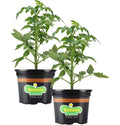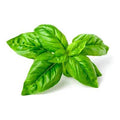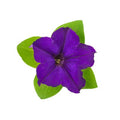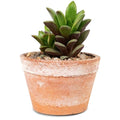Big Beef Tomato (2 Pack)
2-pack starter plants
- Regular price
- $17.99
- Regular price
-
- Sale price
- $17.99
- Unit price
- / per
For years gardeners wanted a large, beefsteak-type tomato that was delicious, early to bear, and highly disease resistant. Finally in 1994 those wishes came true with Big Beef. The large fruit has old-time tomato flavor and the vines are resistant to many of the problems that can discourage gardeners. The fruit is borne on vigorous, indeterminate vines from summer until frost. Compared to other beefsteak types, Big Beef is early and will set fruit reliably even in cool, wet weather. We harvest dozens of tomatoes from each plant in our Alabama test garden, where the harvest season lasts two full months and the growing conditions are very good. It grows well throughout the country, earning it an All America Selections designation in 1994; it has since grown to be a national favorite. Vines grow long, so give the plant the support of a tall cage or stake.
Resistant to verticillium wilt (V), fusarium wilt (F) races 1 and 2, nematodes (N), and alternaria stem canker (ASC), gray leaf spot (St), and tobacco mosaic virus (TMV).
For gardeners who enjoy plant history and interesting facts, Colen Wyatt, the breeder of this variety, was one of the most successful home garden vegetable plant breeders in the last half of the 20th century. He also bred Celebrity and Husky Gold tomatoes, which are both also AAS Winners.
Read More
Read Less
starter plants
pot volume

winner
starter plants
Quantity:
Product Availability:
In Stock
Big Beef Tomato (2 Pack)
- Regular price
- $17.99
- Regular price
-
- Sale price
- $17.99
- Unit price
- / per
Frequently bought together
- Regular price
- $17.99
- Regular price
-
- Sale price
- $17.99
- Unit price
- / per
Key Highlights
- LightFull Sun
- MaturesAt least 73 days after planting
- Fruit Size12 to 16 Ounces
- Plant Spacing36 inches apart
- Plant HeightTall (48″+)
- Planting TimeSpring, Summer
- Determinate/IndeterminateIndeterminate
- Annual/PerennialAnnual
- Pot MaterialGrowers
- SKU202049
How to Grow
Learn how to grow tomatoes. Get tips about growing tomatoes in the ground, raised beds, or containers. Care for tomato plants from planting to harvesting.
View Growing Tomatoes Guide
Delivery Information
Bonnie Plants are carefully packed for secure delivery to your home. All plants are shipped safely in packaging that's 100% recyclable.
Shipping may not be available for all plant varieties.

Welcome to your plant
Remove Packaging
Take each individual bonnie plant out of the box before carefully opening each individual plant’s packaging. Be cautious of soil that may have shifted during transportation.
Check the Soil
Your plants were watered right before shipping, but they may have become thirsty during travel. If the soil is dry to the touch, give your plants a good drink before planting.
Adjustment Period
Let your plants get used to their new environment. Set them in a warm, sunny spot for 34 to 48 hours so they can recover from their trip before being planted.
Long Term Care
1. Location, location
Find the right spot for your plant. Check each plant’s tag for information on how much sun your plan’s need. Growing tip: if your plant needs full sun, a south-facing area will give you the most sunlight. If your plan can grow in part shade, an east or west-facing window might be enough.
2. Soil & drainage
Making sure your container has holes to allow excess water to drain is vital to your plant’s health! We recommend planting your Bonnie Plant in Miracle-Gro Potting Mix for containers, or Miracle-Gro Garden Soil for planting in ground.
3. Hungry plants
Feeding your plants is one of the best ways to improve your plant’s health and maximize your harvest. We recommend feeding with Miracle-Gro plant food when you transplant, and feeding regularly following label directions for best results.
Support
Can’t find the answer you’re looking for? Visit our FAQs or chat with our friendly team.
Where do my Bonnie Plants® come from?
Not far from where you are! We have over 70 growing stations spread across the country, so our plants don’t have to travel far to make it to your garden. That means less time spent in transit, which is better for the plants and for the planet, too. What’s more, each growing station grows varieties that tend to perform well in that particular region, so you don’t have to wonder whether the Bonnie veggies and herbs you buy are suitable for the area you live in.
Does Bonnie sell GMO plants?
No. Every plant we sell is grown from non-GMO seed.
How do I know if a plant is suitable to grow in my area?
Most of the vegetable and herb plants we sell on this site can be grown outdoors throughout the Continental US - however it is important to transplant your starter plant at the right time based on the weather and climate in your area.
Many of our herb plants can also be grown indoors so long as you have sufficient light and water. If you grow herbs indoors, you will still need to transplant your herb plants into properly sized containers with added potting mix.
What is a USDA Hardiness Zone?
The 2012 USDA Plant Hardiness Zone Map is the standard by which gardeners and growers can determine which plants are most likely to thrive at a location. The map is based on the average annual minimum winter temperature, divided into 10-degree F zones.
To learn more, visit https://planthardiness.ars.usda.gov/
How do I care for my plants once I receive them?
Your plant will come with both a care sheet and a plant tag, which gives you information on plant spacing, watering, sunlight and other important considerations to get you started.
Bonnie also has in-depth "How to Grow" guides available here.
How often do I need to water my plants?
A good rule of thumb is an inch of water per week, either by rain or watering; in arid climates, double that. In hot weather, vegetables need even more water, up to about a half an inch extra per week for every 10 degrees that the average temperature is above 60 degrees. You can measure an inch of water by putting a rain gauge or other container under your sprinkler, soaker, drip, or other watering system. You’ve applied an inch of water when the vessel collects water an inch deep. Container gardens may need to be watered more frequently than in-ground garden beds, so check the soil each day and add water if the top inch or so of potting soil is dry.
Related Products
Better Boy Tomato (2 Pack)
High yields of smooth skinned, large fruit earn Better Boy a spot as one of the most popular tomatoes grown in the US and as one of our all time best sellers. The fruit has excellent classic tomato flavor with just the right balance of acid and sugar. This is a great slicing tomato. It is widely adapted throughout the country. Grow it in a tall cage or tie to a stake for support. The indeterminate vines are resistant to verticillium wilt (V), fusarium wilt (F), and nematodes (N). Organic varieties are only available at retailers.
- Regular price
- $17.99
- Regular price
-
- Sale price
- $17.99
- Unit price
- / per
Sweet Green Bell Pepper (2 Pack)
Bonnie's best hybrid sweet bell pepper! A heavy yielder of large fruits. A good all-round pepper for slicing, stuffing, and freezing. This bell produces lots of fresh bell peppers gradually over the growing season. Plants in our Alabama garden produce from June through October, yielding 30 or more peppers from each plant. (Your results will vary based on care and the length of your growing season.) This is a good-sized plant, so be prepared to stake if needed. Organic varieties are only available at retailers.
- Regular price
- $17.99
- Regular price
-
- Sale price
- $17.99
- Unit price
- / per
Red Bell Pepper (2 Pack)
Sweet, juicy, nutritious red fruits add appetizing color to fresh salads and are superb for stuffing. Also great on the grill! The big, blocky peppers (they average around 4 to 6 Ounces) ripen from dark green to bright red. High-yielding plants are well adapted throughout the US. Grow your own and avoid premium prices at the grocery store. Organic varieties are only available at retailers.
- Regular price
- $17.99
- Regular price
-
- Sale price
- $17.99
- Unit price
- / per
Shishito Pepper (2 Pack)
Grow the pepper that’s long been prized by restaurants and is a favorite among chefs. Shishito is a Japanese sweet pepper that produces handfuls of finger-long fruits. Usually used when green (though also fine to eat when red), the peppers are thin-walled, making them ideal for tempura and stir fries. On this side of the Pacific, it’s wildly popular as an appetizer—tossed with oil, then char-grilled or pan-seared to a blackened, blistered state and salted. Plants are compact and perfect for containers. Use one plant per 18-inch pot.
- Regular price
- $17.99
- Regular price
-
- Sale price
- $17.99
- Unit price
- / per
Strawberries (2 Pack)
This everbearing strawberry produces high yields of large, very sweet fruit from late spring through fall. Large, soft, deliciously sweet fruit ideal for jam, preserves, fresh eating, or desserts. Plants are cold-hardy and send out long runners. Great for containers. Plant so that crown is just above soil level.
- Regular price
- $18.99
- Regular price
-
- Sale price
- $18.99
- Unit price
- / per
Best Seller
Beefsteak Red Tomato (2 Pack)
Beefsteaks are always grown for their flavor and size for slicing and summer sandwiches. This variety produces large, meaty red fruit over a long season on indeterminate plants. Because it matures late compared to many other tomatoes, it will provide a fresh harvest in the latter part of the season. This is an old favorite beloved by gardeners in the Northeast and grown throughout the country. Vigorous vines grow best in tall cages. Resistant to fusarium wilt (F) and nematodes (N).
- Regular price
- $17.99
- Regular price
-
- Sale price
- $17.99
- Unit price
- / per
Chives (2 Pack)
Easy to grow, chives pack a lot of flavor for their compact size. The plants form neat grass-like clumps of tubular leaves that contribute an onion flavor to salads, creamy soups, potatoes, egg dishes, and others. A wonderful addition to an herb garden. Great for containers, and also makes a neat border. Enjoy the light purple blooms in the spring--they are edible, too. Frost tolerant. Organic varieties are only available at retailers.
- Regular price
- $18.99
- Regular price
-
- Sale price
- $18.99
- Unit price
- / per
Banana Sweet Pepper (2 Pack)
Named for its banana-like shape, this variety bears sweet, mild banana peppers that mature from yellow, to orange, and then to crimson red. Plants fruit prolifically, easily producing up to 25 to 30 pods per plant. Banana peppers are great for frying and pickling, and are an excellent choice for making pepper rings for sandwiches. Great for containers. Organic varieties are only available at retailers.
- Regular price
- $17.99
- Regular price
-
- Sale price
- $17.99
- Unit price
- / per
Yellow Bell Pepper (2 Pack)
Yellow, thick-walled, sweet fruits add appetizing color and vitamins to fresh salads, and are superb for stuffing as well as fresh use. Plants can get quite large, so be prepared to support them, especially when carrying lots of fruit. Ripens green to yellow.
- Regular price
- $17.99
- Regular price
-
- Sale price
- $17.99
- Unit price
- / per
Green Romaine Lettuce (2 Pack)
This is the classic romaine. Its compact, dark green rosette of tall, upright leaves is slightly curly with white hearts and has a crisp, sweet flavor. Slow to bolt. Grows best in full sun, but will tolerate partial shade and even appreciates it in spring in hot climates. Organic varieties are only available at retailers.
- Regular price
- $17.99
- Regular price
-
- Sale price
- $17.99
- Unit price
- / per
Habanero Hot Pepper (2 Pack)
One of the most potent hot peppers- 100 times hotter than Jalapeño! Great for hot sauces and basting. Wrinkled, tapered little fruit turn from green to orange. Bear very well in hot weather. Grows well in containers. Tapered little fruit turn from green to orange. Bear very well in hot weather.
- Regular price
- $18.99
- Regular price
-
- Sale price
- $18.99
- Unit price
- / per
Italian Oregano (2 Pack)
Savor classic Italian cuisine with the flavorful leaves of this oregano. An easy-growing plant for the garden or container, Italian oregano hails from the Mediterranean region. That means it thrives with lower humidity and well-drained soil. In the garden, use this oregano as an edging plant. Plants spread when happy, rooting along the stems. Harvest leaves or stems anytime during the growing season. Flavor is most intense just before plants flower. Trim plants often to keep flower formation at bay.
- Regular price
- $18.99
- Regular price
-
- Sale price
- $18.99
- Unit price
- / per
Garden Sage (2 Pack)
Gardeners add the uniquely flavored leaves of common garden sage, an herbaceous perennial, to sauces, stuffings, poultry, pork, and sausage. It provides a lovely fragrance and flavor to a dish, especially when leaves are sautéed before adding. It is a good fall and winter plant in hot climates. Great for containers. Needs good drainage. Organic varieties are only available at retailers.
- Regular price
- $18.99
- Regular price
-
- Sale price
- $18.99
- Unit price
- / per
German Queen Heirloom Tomato (2 Pack)
Heirloom. This old-fashioned beefsteak has large, sweet fruits that are lower in acid and quite meaty, making them perfect for slicing. The indeterminate vines will grow tall and bear fruit all summer long, so be sure to stake strongly or cage. One slice makes a great sandwich filling!
- Regular price
- $17.99
- Regular price
-
- Sale price
- $17.99
- Unit price
- / per
Serrano Pepper (2 Pack)
This variety is a vigorous bearer of hot, pungent, candle-shaped fruits that mature from green to bright red. Plants do well in most climates and are especially well adapted to hot, humid areas. This pepper is growing in popularity for pickling and salsa, and is the pepper of choice for making pico de gallo.Organic varieties are only available at retailers.
- Regular price
- $17.99
- Regular price
-
- Sale price
- $17.99
- Unit price
- / per
Buttercrunch Lettuce (2 Pack)
Developed by Cornell University, this heat-tolerant, Bibb-type lettuce has quickly become a favorite since earning All America status in 1963. Its rich green leaves, sometimes tinged with red, form a beautiful rosette in the garden that holds well under stress and has good bolt resistance. A good source of vitamin A and phytonutrients. Grows best in full sun, but will tolerate partial shade and even appreciates it in spring in hot climates.

- Regular price
- $17.99
- Regular price
-
- Sale price
- $17.99
- Unit price
- / per
Snacking Red Pepper (2 Pack)
Talk about goodness from the garden! These deliciously sweet, snack-size red peppers taste so good right off the plant that they might never see the inside of your kitchen. Kids love them for snacks and lunches, and they also taste great in salads and stir-fries. Fruits tend to be slightly smaller than Lunchbox Orange. Great for containers; plant each one in an 18-inch pot. Stake mature plants or surround with a small tomato cage to provide support.
- Regular price
- $17.99
- Regular price
-
- Sale price
- $17.99
- Unit price
- / per
Tabasco Hot Pepper (2 Pack)
Heirloom. This hot pepper is used to make the famous Tabasco® Sauce. Peppers mature from yellow-green to orange to red and have a unique, smoky flavor that contributes to Tabasco's distinctive taste. While adapted to all areas of the US, plants produce continuously and will therefore produce the most peppers in the South and Southwest, where the growing season is longest. In frost-free areas, plants can live for several years. Easy to grow, the compact Tabasco is also a good choice for containers.
- Regular price
- $17.99
- Regular price
-
- Sale price
- $17.99
- Unit price
- / per
Spinach (2 Pack)
This variety of dark green spinach has been a standout in many regions, including the North. It is slow to bolt and suitable for spring, summer, and fall planting. The full, upright plants produce high yields of large, triangular leaves that are rich in the phytonutrient lutein. Both frost and heat tolerant.
- Regular price
- $17.99
- Regular price
-
- Sale price
- $17.99
- Unit price
- / per
Big Boy Tomato (2 Pack)
The name, Big Boy, is easy to remember and so is the flavor. This is a big, sandwich-type slicer with smooth, bright red fruit and a flavor that everybody likes. It bears heavily in mid-season, yet the indeterminate vines continue fruiting (though not as heavily) until frost. Plants in our Alabama test garden, where conditions are excellent, have yielded 100 tomatoes each through a 10-week harvest season. Long vines need staking, or grow the plant in a tall cage. Resistant to cracking.
- Regular price
- $17.99
- Regular price
-
- Sale price
- $17.99
- Unit price
- / per
Spearmint Mint (2 Pack)
Spearmint has strong flavor and fragrance that is released with simple bruising. It's the best mint variety for hot and cold drinks. Toss bruised leaves into ice water for a refreshing summer drink or add to iced tea. Spearmint is favored for flavoring beverages such as mojito. Also know as Yerba Buena. Spreading plant is great for containers. Tolerates light frost.
- Regular price
- $18.99
- Regular price
-
- Sale price
- $18.99
- Unit price
- / per
English Thyme (2 Pack)
English thyme is a low-growing plant with fragrant leaves. This herb goes well with just about everything. Add it (fresh or dried) to blended herb mixtures, or use in soups, sauces, beans, meat dishes, and more. It’s also a great addition to potpourri or homemade soap. But thyme isn’t just useful inside the house, as it also makes a wonderfully aromatic ground cover or border.
- Regular price
- $18.99
- Regular price
-
- Sale price
- $18.99
- Unit price
- / per




 Herbs
Herbs
 Vegetables
Vegetables
 Fruit
Fruit
 Flowers
Flowers
 Succulents
Succulents